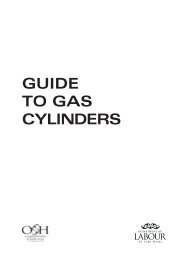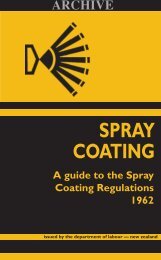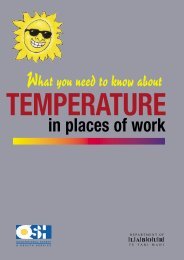Underground Petroleum Storage Tanks and Related Wastes - Code ...
Underground Petroleum Storage Tanks and Related Wastes - Code ...
Underground Petroleum Storage Tanks and Related Wastes - Code ...
You also want an ePaper? Increase the reach of your titles
YUMPU automatically turns print PDFs into web optimized ePapers that Google loves.
Refer to appendix 1. The principal’s number should be on the tank <strong>and</strong> should be<br />
cross referenced with the permanent identification number.<br />
Any tank that is holed or unsound should be placed on the disposal pad at the time<br />
of delivery to the disposal site. It should have any product pumped out <strong>and</strong> be<br />
thoroughly steamed or water washed internally prior to being stored awaiting<br />
processing.<br />
11. TANK PROCESSING AND DISPOSAL<br />
11.1 Preliminary<br />
Too many tanks have exploded when believed safe. Take every care. Do not let it<br />
happen to you.<br />
IF IN DOUBT, DO NOT PROCEED!<br />
Treat all tanks as hazardous until checked, tested <strong>and</strong> certified gas free immediately<br />
before processing.<br />
11.2 Hazards<br />
The special hazards that must be managed are:<br />
• Explosion <strong>and</strong> fire<br />
• Toxic materials<br />
• Asphyxiation<br />
11.3 Explosion or Fire<br />
Flammable vapour + air + ignition = fire.<br />
Fire in a confined space = explosion.<br />
Petrol, gasoline, kerosine <strong>and</strong> other light products = flammable vapour.<br />
Diesel, lubricating oil <strong>and</strong> other heavier products + heat = flammable vapour.<br />
Avoid fires <strong>and</strong> explosions by eliminating one or more of the three factors —<br />
vapour, air or ignition source.<br />
11.4 Eliminate Vapour<br />
Less than a litre of product is needed to produce an explosive vapour in a 30,000<br />
litre tank. This could come from sludge or scale remaining in a tank.<br />
Any trace of product remaining in a tank, even in the form of damp sludge or<br />
scale, indicates the probable presence of an explosive vapour.<br />
Always wear appropriate breathing apparatus when approaching or working with a<br />
tank that is being purged of vapour.<br />
Only tanks with manholes can be properly cleaned <strong>and</strong> tested for product or vapour.<br />
<strong>Tanks</strong> without manholes must always be treated as hazardous until they have been<br />
opened up, thoroughly ventilated <strong>and</strong> cleaned.<br />
Prolonged natural ventilation, over several weeks may allow all vapour to escape<br />
from a Class 3(a) product tank (petrol <strong>and</strong> other volatile highly products) provided<br />
the tank is raised on blocks at least 300 mm clear of the ground, in a horizontal<br />
Transport <strong>and</strong> Disposal of <strong>Petroleum</strong> <strong>Storage</strong> <strong>Tanks</strong> 15





